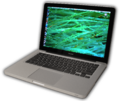Pixelization facts for kids
Pixelization is a special way to hide parts of an image or video. It makes certain areas look blurry or blocky, like a mosaic. People use pixelization to keep secrets, protect privacy, or follow rules about what can be shown.
Contents
What is Pixelization?
Pixelization happens when an image is shown with very large "pixels." Pixels are tiny squares that make up every digital picture. When you zoom in on a digital photo, you might start to see these small squares. Pixelization makes these squares much bigger, so you can't see the details of what's underneath.
Why Do We Use Pixelization?
There are a few main reasons why pixelization is used:
- To Hide Information: Sometimes, a document or screen might have private details, like names, addresses, or secret plans. Pixelization makes these details unreadable. This is often done before a photo is shared with the public.
- For Privacy: If someone doesn't want their face to be seen in a photo or video, pixelization can hide it. This protects their identity and privacy. It's common in news reports or documentaries.
- For Copyright Reasons: Sometimes, an image might contain artwork, logos, or other things that are protected by copyright. To avoid breaking copyright rules, those parts of the image might be pixelated. This way, the original creator's rights are respected.
- To Censor Content: In some cases, pixelization is used to hide parts of a picture or video that are not suitable for everyone, especially younger viewers. This helps to make sure content is appropriate for its audience.
How Does Pixelization Work?
Imagine a picture made of millions of tiny colored LEGO bricks. Pixelization is like replacing a small group of these tiny bricks with one much larger, single-colored brick. When you do this over an area, all the fine details disappear, and you just see big blocks of color. The more an image is pixelated, the less you can see of the original.
Images for kids
-
Marshall B. Webb, an American general, sits in the White House Situation Room during Operation Neptune Spear. A classified document on the desk in front of him was pixelized by the government of the United States before the photo was released.
See also
 In Spanish: Pixelización para niños
In Spanish: Pixelización para niños



